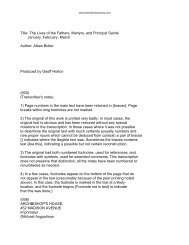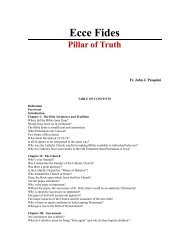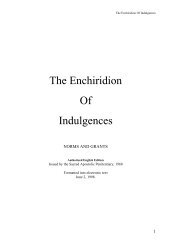Ascent of Mt. Carmel - St. Patrick's Basilica
Ascent of Mt. Carmel - St. Patrick's Basilica
Ascent of Mt. Carmel - St. Patrick's Basilica
Create successful ePaper yourself
Turn your PDF publications into a flip-book with our unique Google optimized e-Paper software.
and fourth, however, are justified, and for these, as for a few minor improvements, the<br />
editor deserves every commendation.<br />
The remaining years <strong>of</strong> the eighteenth century produced few editions; apart from<br />
a reprint (1724) <strong>of</strong> the compendium <strong>of</strong> 1701, the only one known to us is that published<br />
at Pamplona in 1774, after which nearly eighty years were to pass before any earlier<br />
edition was so much as reprinted. Before we resume this bibliographical narrative,<br />
however, we must go back over some earlier history.<br />
VII<br />
NEW DENUNCIATIONS AND DEFENCES -- FRAY NICOLçS DE JESòS MARêA --<br />
THE CARMELITE SCHOOL AND THE INQUISITION<br />
WE remarked, apropos <strong>of</strong> the edition <strong>of</strong> 1630, that the reasons which led Fray Diego de<br />
Jesœs to mutilate his texts were still in existence when Fray Jer—nimo de San JosŽ<br />
prepared his edition some twelve years later. If any independent pro<strong>of</strong> <strong>of</strong> this statement<br />
is needed, it may be found in the numerous apologias that were published during the<br />
seventeenth century, not only in Spain, but in Italy, France, Germany and other<br />
countries <strong>of</strong> Europe. If doctrines are not attacked, there is no occasion to write vigorous<br />
defences <strong>of</strong> them.<br />
Following the example <strong>of</strong> Fray Basilio Ponce de Le—n, a pr<strong>of</strong>essor <strong>of</strong> theology in<br />
the College <strong>of</strong> the Reform at Salamanca, Fray Nichol‡s de Jesœs Mar’a, wrote a<br />
learned Latin defence <strong>of</strong> <strong>St</strong>. John <strong>of</strong> the Cross in 1631, <strong>of</strong>ten referred to briefly as the<br />
Elucidatio. 53 It is divided into two parts, the first defending the Saint against charges <strong>of</strong> a<br />
general kind that were brought against his writings, and the second upholding censured<br />
propositions taken from them. On the general ground, P. Nichol‡s reminds his readers<br />
that many writers who now enjoy the highest possible reputation were in their time<br />
denounced and unjustly persecuted. <strong>St</strong>. Jerome was attacked for his translation <strong>of</strong> the<br />
Bible from Hebrew into Latin; <strong>St</strong>. Augustine, for his teaching about grace and free-will.<br />
The works <strong>of</strong> <strong>St</strong>. Gregory the Great were burned at Rome; those <strong>of</strong> <strong>St</strong>. Thomas Aquinas<br />
at Paris. Most mediaeval and modern mystics have been the victims <strong>of</strong> persecution --<br />
Ruysbroeck, Tauler and even <strong>St</strong>. Teresa. Such happenings, he maintains, have done<br />
nothing to lessen the eventual prestige <strong>of</strong> these authors, but rather have added to it.<br />
Nor, he continues, can the works <strong>of</strong> any author fairly be censured, because<br />
misguided teachers make use <strong>of</strong> them to propagate their false teaching. No book has<br />
been more misused by heretics than Holy Scripture and few books <strong>of</strong> value would<br />
escape if we were to condemn all that had been so treated. Equally worthless is the<br />
objection that mystical literature is full <strong>of</strong> difficulties which may cause the ignorant and<br />
pusillanimous to stumble. Apart from the fact that <strong>St</strong>. John <strong>of</strong> the Cross is clearer and<br />
more lucid than most <strong>of</strong> his contemporaries, and that therefore the works <strong>of</strong> many <strong>of</strong><br />
them would have to follow his own into oblivion, the same argument might again be<br />
applied to the Scriptures. Who can estimate the good imparted by the sacred books to<br />
those who read them in a spirit <strong>of</strong> uprightness and simplicity? Yet what books are more<br />
pregnant with mystery and with truths that are difficult and, humanly speaking, even<br />
53Phrasium mysticae Theologiae V.P. Fr. Joannis a Cruce, <strong>Carmel</strong>itarum excalceatorum Parentis primi<br />
elucidatio. Compluti, 1631.<br />
42






